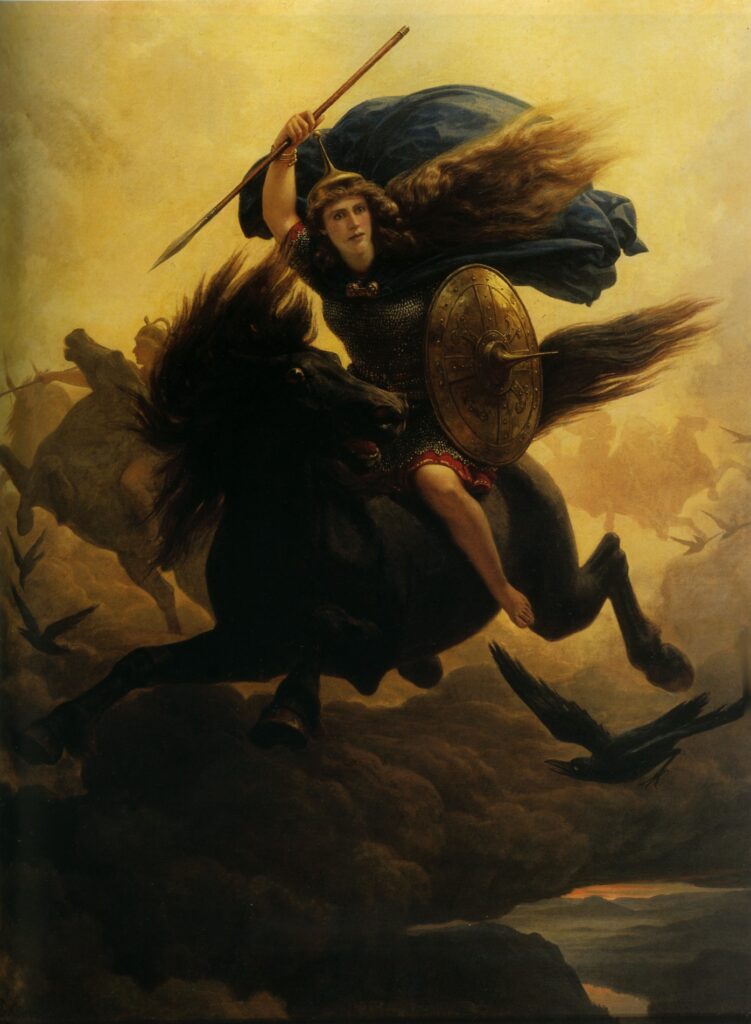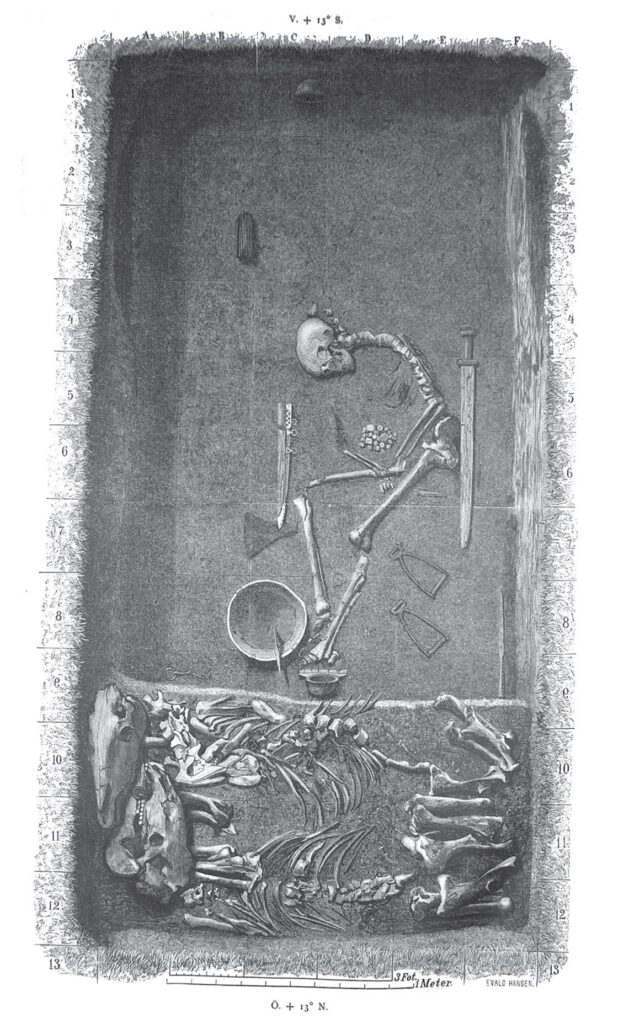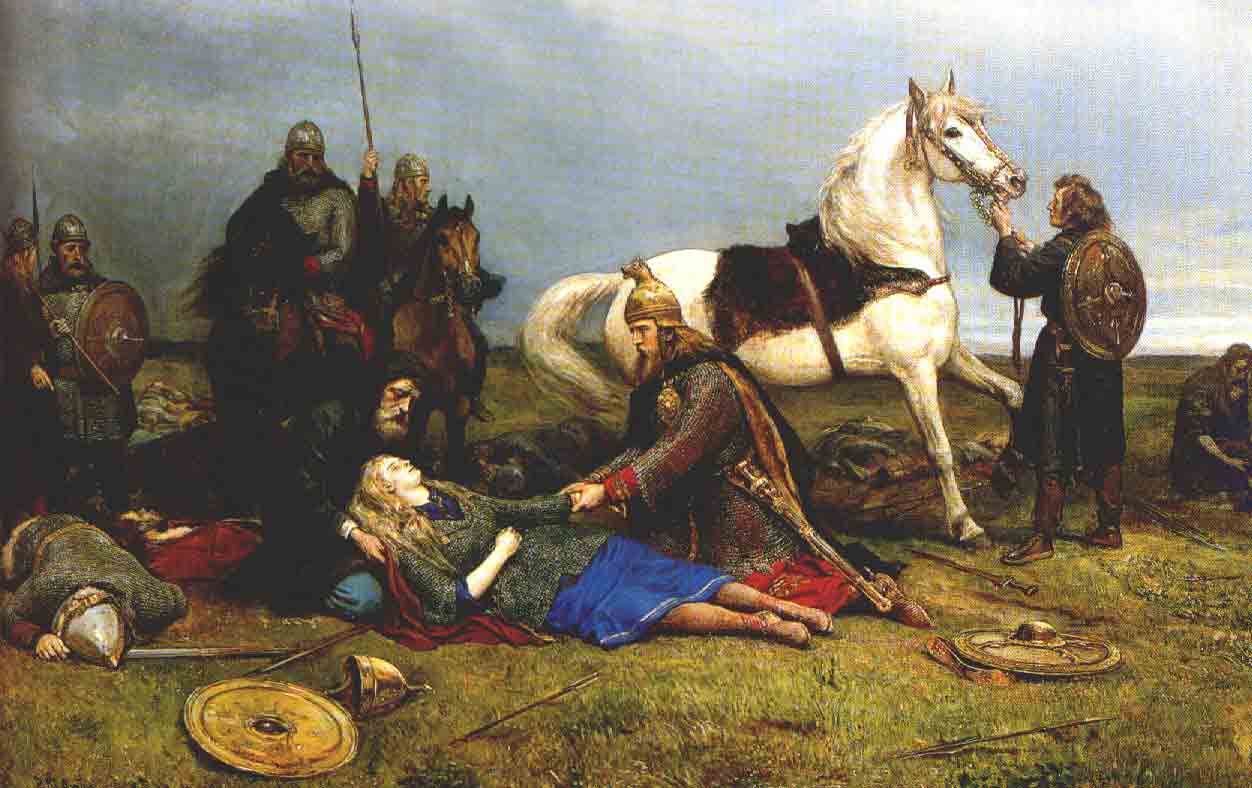Gender roles in past societies have been the focus of greater study since the introduction of gender theory in the 1960s. Despite being studied for some 60 odd years, however, old assumptions about women’s roles in Viking Age society have continued to shape archaeological conclusions. When women have been found buried with artefacts typically assigned to males, such as weapons, researchers have often found these confounding to interpret. To do so, they have often looked to mythology and sagas, which often feature accounts of great female warriors.
One being that encompasses both female and male stereotypical gender traits is the valkyrie. Valkyries are complex and somewhat misunderstood beings, with a variety of interpretations. On a poetic level, they may function as the embodiment of the horrors of war. But arguably they are most famous as the handmaidens of Odin, who select which warriors will die upon the battlefield and then bring half of them to the hall of Valhalla, where they serve them mead. The latter interpretation likely stems from a certain amount of historical romanticization of the mythical creatures. The word “valkyrie” literally means “chooser of the slain”, but their role as the waitresses of Valhalla and handmaids of its lord are more likely to be based on the gender roles of medieval and modern society. The same may be said of the way they have been sexualized.

The famous status of the valkyrie has led some researchers to apply the label to a broad range of archaeological findings: amulets of women carrying weapons, or even graves of armed women. But assuming that a woman buried with weapons must be a symbolic valkyrie, not an actual warrior, is problematic—not least as there are also episodes from the same literature in which mortal women pick up weapons to fight.
A famous example is the story of Freydís Eiríksdóttir, in the saga of Eirik the Red. Freydís was the illegitimate daughter of Eirik the Red himself, and is at times referred to as ‘odd and manly’. When she travelled to Vinland the camp they set was attacked by natives, who surrounded the Vikings so that they were forced to retreat. Freydís then emerged from her hut—heavily pregnant, mind you!—and when she saw the men retreating, she started berating them as cowards saying “Let me have one weapon and I’ll fight better than all of you.” She started following them into the woods, and when surrounded by her foes she pulled a sword from the hand of a fallen warrior, baring one breast and slapping the sword against it. This frightened the natives so much that they ran away.
Written sources must always be observed with a critical eye for the bias of the person who wrote them, especially when those sources do not date to the period they describe. However, it is important to note that these sources are usually complimentary towards the women who take up weapons: Audr in Laxdaela saga took up weapons to defend her own honour when her brothers would not, and she was much praised for it afterwards. An example from the legendary sagas is Hervör, who rejects “feminine” activities in her youth and instead trains with weapons. She eventually leads a band of Vikings, retrieves her berserker father’s sword from his grave (after persuading his ghost), and becomes a retainer for a king—much of which she did while taking a male name, Hervard.
The above mentioned examples are only isolated examples of women in the sagas. Although these accounts are often mythologised in their own way, they do seem to suggest that women had the opportunity to fall into the male gender role—if they proved themselves, by acting sufficiently manly. When these accounts, which reveal cultural sensibilities if not always true events, are compared with the archaeological material, the idea that women could become warriors in this society is not so very far-fetched.

At least, this should be enough to re-examine our old views of gender in the Viking Age and how female graves with “male” attributes, or amulets portraying women with weapons, can be interpreted. Interpretations that reject outright the possibility of actual female warriors not only reject the simplest explanation of the archaeological evidence, but they also go directly against the attestations of the saga literature. This is especially untenable if we instead resort to mythological literature for our explanations.
Women were clearly not simply passive objects in this (or any) society, nor were they likely the highly sexualised fantasy figures of the modern day. Mythology may well be involved in some of these findings, but resorting to mythology to explain any remains that defy our expectations denies real women the agency they undoubtedly held. If we want to more fully understand the role of Viking Age women, should it not be our own biases that require a closer look?
Copyright: Anna Sunneborn Guðnadóttir. Copyright 2021 Scandinavian Archaeology.
Cover image: Hervör’s death after the Battle of the Goths and Huns, by Peter Nicolai Arbo (1880).
About the author

Anna Sunneborn Guðnadóttir
Archaeologist with a bachelor in archaeology from Uppsala University (Sweden), a Masters from University College London (UK), and a Masters from Uppsala University (Sweden).
During my masters studies I focused on the archaeometric side of archaeology - mainly Geographic Information Systems, geoarchaeology and optical microscopy. In my MA dissertation at UCL I used micromorphology and ceramic petrography to attempt to trace ancient artefacts to its manufacturing location based on modern soil samples and literary sources. My MA dissertation at Uppsala University was a digital analysis of a settlement based on the ceramics found during excavation.
I have a love for all things stratigraphy and geoarchaeological, and can often be found looking at stratigraphy wherever I can find it.


